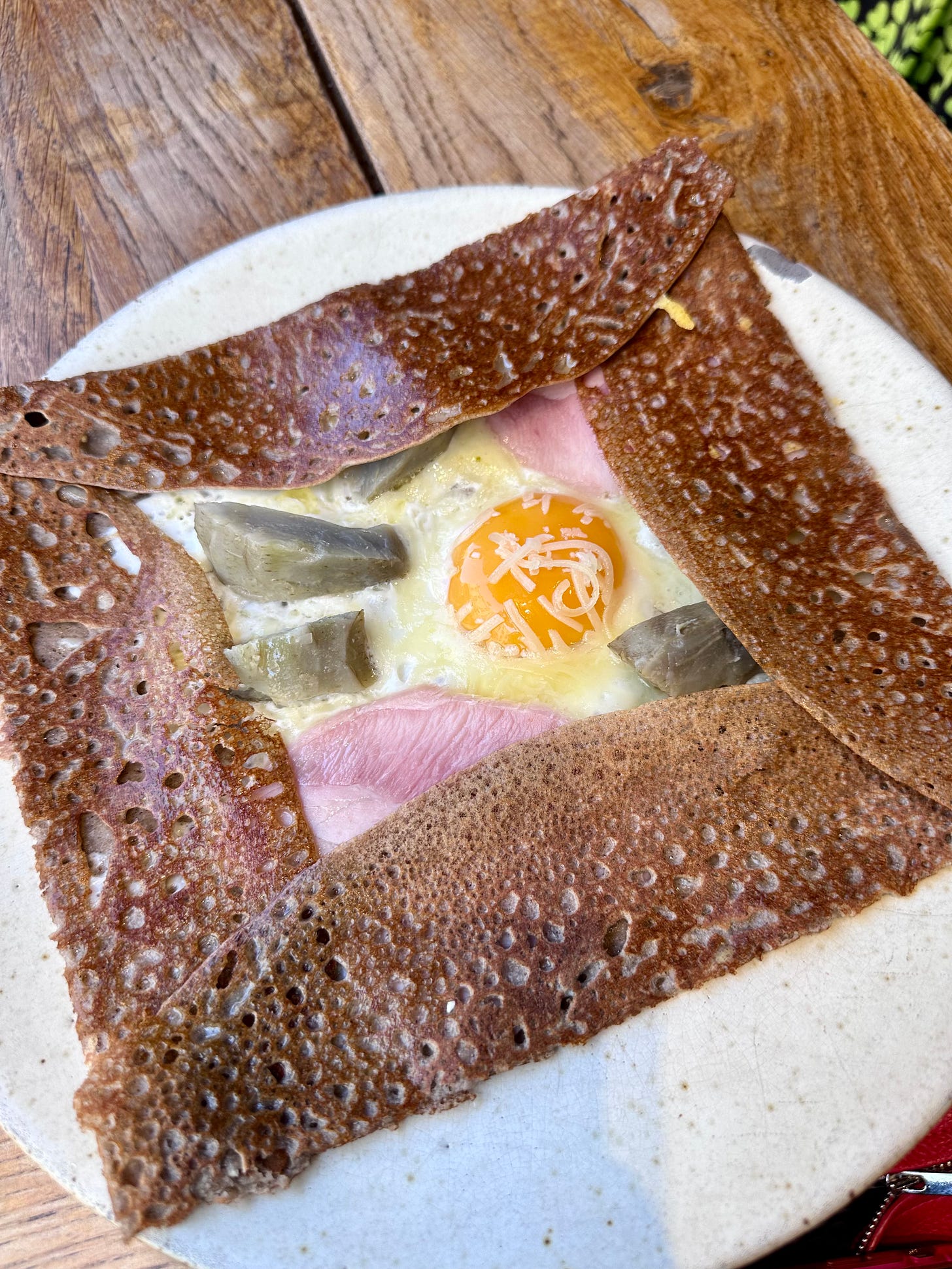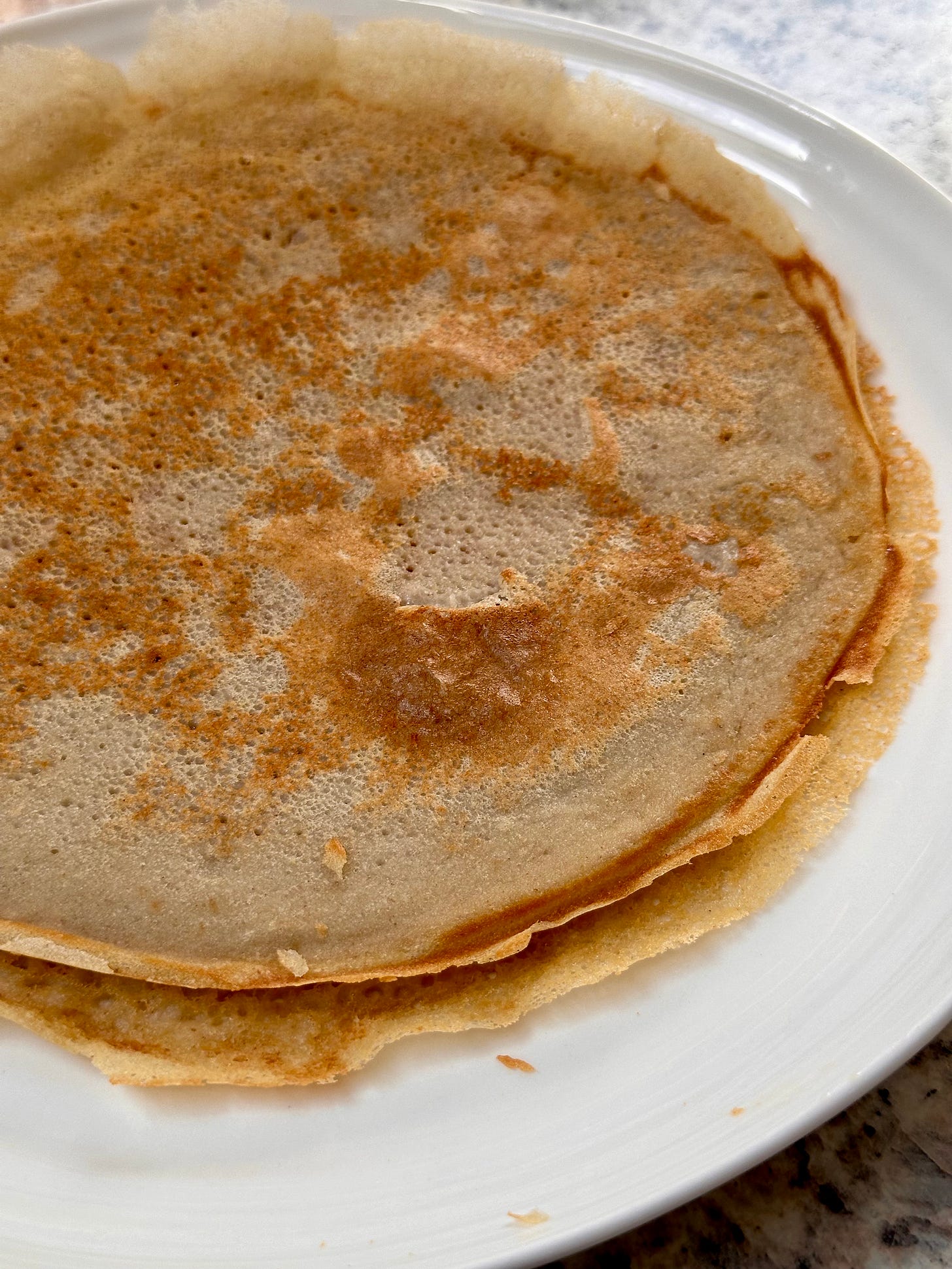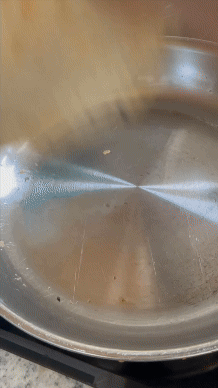Welcome to Small Wins, a newsletter that shares a small win with you every other week — one that has the power to improve your cooking, your home, your life. If you’ve found your way to this newsletter but are not yet subscribed, here, let me help you with that:
Nostalgia plays a huge role in our food preferences and, for me, a childhood spent in Paris means that a lot of my core food memories are French: little brioche buns garnished with pearl sugar; still-warm baguettes from the boulangerie on the corner; rotisserie chicken from the local market; a slice of French yoghurt pot cake for goûter (the afternoon snack). And so it is with today’s small win: the humble buckwheat galette.
In case anyone needed reminding (not me!), it is Pancake Day on Tuesday and there are two reasons you might like to consider making buckwheat crepes in lieu of the classic kind:
You prefer savoury over sweet
You are gluten-free (or catering for someone who is)
Buckwheat is a part of the rhubarb family and an ancient seed that can be ground into an earthy flour that delivers unique depth of flavour. Not only is it delicious, but it’s also one of the darlings of the gluten-free world, containing no wheat or gluten (in spite of what its name would suggest).
I do hope that you try these buckwheat crepes: they are delicious, nutritious and straightforward to make. Happy Pancake-ing!
Love,
Alexina
Coming up on Small Wins — The easiest + quickest “bread” in the world. The best cake to make with kids (no scales!). The single most essential technique for roasting a chicken.
For my Small Wins+ community — Tomorrow, in Pancakes 101, I will share all the best pancake recipes with you (something I’ve been researching and testing for years). We’ll cover the secret ingredient for the best crepes, pancakes for the lazy person (there is no need for a packet mix, I promise), the cutest pancakes in the world and much more. Become a paid subscriber to gain access.
BRITTANY’S EQUIVALENT TO THE CORNISH PASTY?
Whilst I have called this newsletter ‘the forgotten pancake’, I’m not sure buckwheat galettes have ever had much of a life outside of France — so perhaps they’ve not had the chance to be forgotten.
This lack of fame represents a collective loss since buckwheat galettes are uniquely delicious and make for an easy and satisfying solo lunch (much like the Cornish pasty, you could argue, though I doubt the French would appreciate the comparison).
Buckwheat crepes have a nutty, earthy flavour that lend themselves perfectly to savoury preparations. A quintessential, easy lunch in France is a galette complète: a buckwheat crepe filled with cheese, ham and an egg. But the beauty of a galette is that it can be filled with just about anything.
In France, you can buy readymade buckwheat crepes in the supermarket, which makes them the ultimate convenience food, but it’s also pretty straightforward to make your own.
Helpfully, the batter can hang out in the fridge for up to 5 days or you can freeze cooked crepes for up to 3 months, ready to turn them into galettes at relatively short notice (they don’t take long to defrost).
And whilst I don’t like to have 500 different flours in my cupboard, buckwheat is one that I always have to hand — mainly to make these galettes, but also for blinis, chocolate cookies and other gluten-free baking and desserts.
I don’t think I can emphasise how much I love galettes — they are easily a top 10 dish for me — so the fact that they fly under the radar outside of France is a bit of a mystery! Have you tried them?
AN ENTRY FOR YOUR PARIS ADDRESS BOOK
Breizh Cafe serves the best Breton-style buckwheat galettes and sweet crêpes in Paris. Now a small chain, the OG spot in the Marais is the one that I always return to. Some of the other locations are a bit fancier and more ‘Parisian’, but this one remains very ‘Breton’ in vibe: which is to say that the fit-out is elementary and heavy on the wood — très rustic-chic.
What I love about Breizh Cafe is that it is both earthy and elevated — something which makes perfect sense when you discover that the owners are a Franco-Japanese couple. The buckwheat crepes and ciders (all 60 of them!) are unmistakenly Breton, but some of the fillings head in a gourmet direction: think pan-fried scallops with creamed leeks and seaweed butter, or smoked herring with Saint Malo potatoes. Japanese flavours are woven in too: sweet crepes are topped with Bordier yuzu butter, or matcha ice cream.
The ingredients used at Breizh Cafe are top quality and you can taste it. I’ve never had a bad meal here, nor an expensive one. Be sure to visit the next time that you’re in the City of Lights and, if you can, get yourself a spot from which you can people watch…
A RECIPE FOR BUCKWHEAT CREPES
Traditional Breton crepes are puritanical, made with just buckwheat flour, water and salt. Unfortunately, they are pesky to get right: the consistency of the batter needs to be just so, they require an overnight stint in the fridge, you need a bilic (or at least a proper non-stick crepe pan) to cook them, and they’re delicate as anything. So whilst I would have loved to share the traditional version with you, I didn’t want to put you through the jeopardy.
Instead, I’ve developed a recipe that is accessible, straightforward and foolproof whilst still capturing the essence of a French galette de sarrasin. The addition of an egg and some milk (any type works) helps the crepes to hold together, whilst the melted butter helps to prevent sticking (a handy addition to any crepe batter that you’re having problems with). The result is lacy, savoury, gluten-free crepes with the nutty depth of buckwheat.
This recipe also makes a great gluten-free sweet crepe — simply replace the water with your milk of choice and add 1 tbsp caster sugar to the flour.
Makes around 6 x 23cm/9” crepes
Ingredients
50g butter, plus extra for cooking
100g buckwheat flour — I strongly recommend Doves Farm buckwheat flour (which I used to develop this recipe) since variations between brands can be considerable
1/4 tsp fine sea salt
1 medium egg
150ml milk (any kind, unsweetened) — the flavour of oat milk works best with the buckwheat, in my opinion
150ml water
Equipment
A crepe pan or large frying pan — if you want to fill them in the French way (see the picture above), then the larger your pan is, the better
Blender (useful, not essential)
Cup measures (useful, not essential)
Method
To make the crepes:
Melt the butter in the frying pan on the lowest heat.
Add the rest of ingredients to a blender. Blend on medium speed until smooth, 30 seconds to 1 minute. The batter should have a consistency a notch or two thicker than double cream. Transfer to a jug (or bowl) and whisk in the melted butter. Place aside until ready to cook (you can store the batter, covered, in the fridge for up to 5 days).
If making by hand, stir together the flour and salt in a large jug (or medium bowl), then whisk in the egg and milk until you have a smooth, lump-free batter. Whisk in the water, followed by the melted butter.
To cook the galettes, place the frying pan on a medium-high heat (my induction hob has a range of 1 to 9 and 5 is the level that I use). Allow to heat up for a good 3 to 4 minutes then rub a little melted butter over the surface, wiping off an excess with a piece of kitchen roll.
Pour the batter into the hot pan and tilt the pan to get it to cover the surface evenly.
With galettes you want something a little thicker and sturdier than a typical crepe. I find a 1/3 cup of batter to be the perfect amount for my 26cm/10” frying pan with sloping sides — but depending on the size of your pan you may need less or more.
Use the first couple of pancakes to work out the right amount of batter and also the right temperature for your pan! You’ll find your rhythm, I promise.
Allow to cook until the edges start to come up from the pan and the underside is a deep golden brown, around 4 to 6 minutes. Run an offset spatula along the perimeter of the crepe, then flip it — I find it easier to use my hands to do this: carefully grab one edge of the crepe and flip in one swift motion. Cook the second side for another couple of minutes (or until set) and transfer to a plate. Repeat with the remaining batter.
If you’re finding it challenging to flip the pancakes with your hands, cover the pan with a large plate, flip the pan over, place it back on the hob and slide the crepe back into the pan, cooked side up.
Serve your crepes as you wish — they can be used for any kind of savoury pancake dish, or topped with sweet toppings in the traditional way. If you’d like to make French galettes, read on…
To turn your crepes into a meal:
Shown above is my non-traditional galette filling of za’atar, grated emmental, egg and honey — but the approach is pretty much the same regardless of which filling you choose (some filling ideas are shared further below).
Remember that anything that needs significant cooking or heat (e.g. greens, mushrooms, raw seafood or meat) will need to be cooked prior to going in the crepe. I tend to gravitate towards fillings that don’t require that extra step, such as the one shown above.
I should also say: ready-grated emmental is by far the best cheese for this — it melts quickly and evenly, and has the perfect flavour.
Right, onto the galette-making.
The pan does not need to be as hot as it was when you were cooking the crepes — I go down to a low/low-medium heat (number 3 out of 9 on my induction hob). You also won’t need to add any more butter to the pan if you’re making these straight after cooking the crepes.
Add the cooked crepe, then spread over the grated cheese (either evenly or in a ring form if you’re going to be adding an egg). Crack the egg into the middle of the cheese ring, if applicable. Then add the rest of the ingredients (except any garnishes).
When the cheese is starting to melt, push the edges of the crepes in on all four sides to create a square (the melted cheese will help the sides to stick)*. Cover with a lid and cook for 3 to 4 minutes. Transfer to a plate and garnish with fresh herbs, if using. Eat straightaway.
*This works best with crepes that are at least 28cm/11” — if working with smaller ones, I find it easier to place the fillings on one side of the crepe and fold it in half.
Some filling ideas
An egg + grated emmental + za’atar + a very light drizzle of honey (so good, please try it!)
Ham + grated emmental + an egg (the traditional ‘galette complète’ — can’t go wrong)
Sautéed mushrooms + grated emmental + an egg + chives
Smoked salmon + leeks sweated in butter + crème fraîche
Wilted spinach + grated emmental + an egg + nigella seeds + dill
Ham + grated emmental + artichoke hearts (drained from a jar) + lots of pepper
Crispy fried sausagemeat + grated emmental + wilted cavelo nero with garlic
Sautéed mushrooms + leeks sweated in olive oil + crumbled blue cheese + lots of black pepper
FURTHER READING + RESOURCES
Gluten-free? Other good options for carby-type things are Italian farinata, proper Mexican tacos made with masa harina (you can also make these yourself) and these clever ‘skinny omelettes’ where eggs are cooked thin and crepe-like.









